#lludd and llefelys
Text
Lludd and Llefelys
“Lludd and Llefelys” is a fascinating tale from “The Mabinogion,” the collection of Welsh medieval legends. The story revolves around the two brothers, Lludd and Llefelys, and their quest to overcome three plagues that afflict the island of Britain. Here’s an abridged version of the story:
Lludd was the wise and just king of Britain, known for his wisdom and good governance. However, his kingdom…
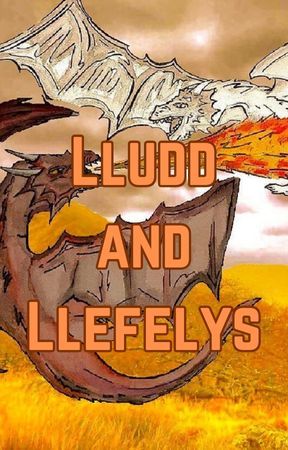
View On WordPress
#ancient kingdoms#ancient legends#British folklore#British mythology.#brotherly bonds#Coraniaid#King Llefelys#King Lludd#Lludd and Llefelys#magical creatures#medieval Welsh culture#Spirit of Vengeance#supernatural plagues#tales of wisdom and courage#The Mabinogion#triumph over evil#Two Dragons#Welsh kings#Welsh literature#Welsh mythology
0 notes
Note
PLEASE TELL US ABOUT Y DDRAIG TRAWS!
Certainly! I'm more than happy to oblige.
First though I'm gonna need to tldr: the history of Y Ddraig Goch before we get onto the (accidentally) canonically trans part.
A brief history of Y Ddraig Goch:
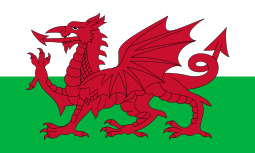
(The modern Welsh flag)
Y Ddraig Goch first appears in the tales of the Mabinogi (Charlotte Guest version) in the tale of Lludd and Llefelys where it is fighting a white dragon. The fight is also described/expanded upon in the c. 829 AD text Historia Brittonum (attributed to Nennius) - where the red dragon represents Wales and the white dragon represents the Anglo-Saxons. In the story the red dragon triumphs over the white. Of course, Geoffrey of Monmouth also covers the story c. 1136 in Historia Regnum Brittaniae in which he introduces the concept of the red dragon heralding the arrival of King Arthur.
Geoffrey of Monmouth claims Arthur used a banner featuring a golden dragon. But we also know the accuracy of Monmouth can be questionable at times. Owain Glyndŵr did use a banner with a golden dragon called Y Ddraig Aur - raised in 1401 at Caernarfon - Glyndŵr chose this banner as a nod to the supposed banner of Arthur and his father.
Later on the Tudor monarchs (being a Welsh family) adopted a red dragon on a white and green background in their heraldry. Eventually Y Ddraig Goch on a white and green background became the official badge of Wales in 1800. The design became the official flag of Wales in 1959.
Y Ddraig Traws:
Now for the thing you're all here for -
So, as outlined, the history of the dragon as a national symbol of Wales goes back a long way. If we're just talking post-1959, there's some interesting implications for Y Ddraig Goch's depiction.
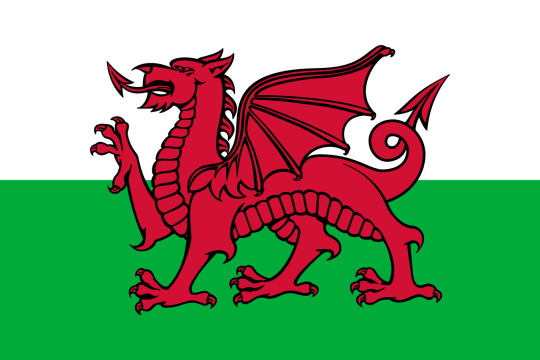
This is what the Welsh flag (and Y Ddraig Goch) looked like in 1959 when it was officially adopted as the flag of Wales. It looks broadly the same as the first flag and has some common features - such as not having a penis (or, as in the correct heraldic terminology - a pizzle). Meanwhile, in the arms of the Tudors (specifically Henry VII)
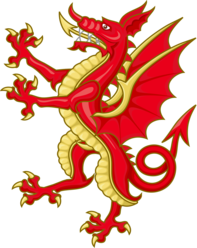
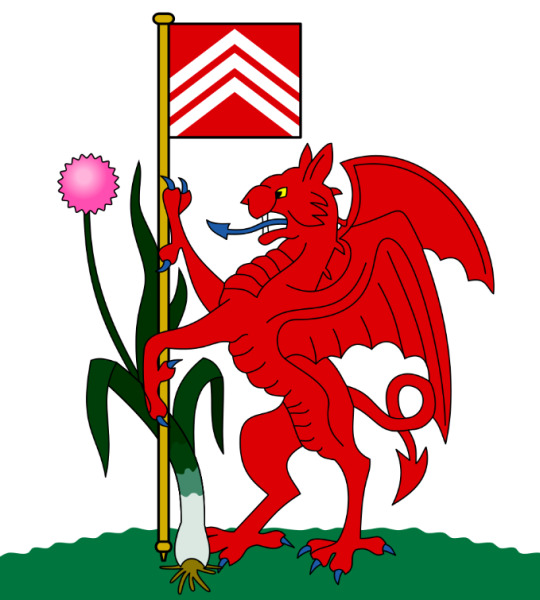
(Tudor dragon with pizzle) vs (dragon on the flag of Cardiff - pizzleless)
the penis is almost always included. So much to the point that the present royal family still includes the penis. While pretty much 0 depictions of the dragon in Wales include a penis. So you could interpret this as the dragon is seen as male only by the British royal family and as female everywhere else (which kinda implies that at some point the Tudor dragon had an mtf transition in Wales and she keeps getting misgendered by the royal family every time she is depicted in (mostly) England).
So much to the point that in 1995 this pound coin was made by the Royal Mint featuring the pizzle on the dragon with all four feet touching the ground as opposed to standing up (passant rather than rampant).

But in Wales you'd be hard pressed to see a pizzled dragon anywhere. Ergo, we can only conclude Y Ddraig Goch is trans and she transitioned in Wales and keeps getting misgendered in England.
[note: This is mostly tongue in cheek - but I do think it's fun to extrapolate that the Welsh dragon is trans because of the differences in depiction between Wales and England. Like many things Welsh, it is misrepresented by England and the idea of the Welsh dragon being misgendered only in England is, I think, a good metaphor for a whole lot of English treatment of Wales.]
Unrelatedly, there is a gay Welsh flag held at the National Museum of Wales which has a very wonky dragon which I find very endearing.

(cleaned up version I made)
So much so I made it an emoji in my Welsh bilingual LGBTQIA+ Discord (requirements for joining are - be 16+, either speak or are learning Welsh and identify as LGBTQIA+ in some way. Dm for link!).

(triaist ti 'you tried' emoji)
~ Completely unrelatedly ~ never forget the time someone was trying to homophobic to me by suggesting that I was disrespecting all the soldiers who died 'for the Welsh flag' by making it rainbow colours and not red - arguing that any change of colour of the dragon was disrespectful. Reader, my bus pass at the time for Mid Wales Travel had a purple dragon on it.
#cymraeg#welsh#cymblr#cwiar#trawsryweddol#traws#trans#trans dragon#y ddraig goch#welsh dragon#welsh history#dragons#wyverns#last tag because technically Owain's golden dragon is technically a wyvern
490 notes
·
View notes
Text
Mabinogion posting for @liminalpsych
Not all of the stories in the Mabinogion relate to Arthurian Legend. However I recall you've been reading Geoffrey of Monmouth's Historia Regum Britanniae, and two of the stories, The Dream of Maxen and Lludd and Llefelys, tie into that. So they might still interest you!
The version I own for annotation was translated by Jeffrey Gantz for Penguins Classics in 1976. As far as I know, a PDF of this doesn't exist. But I favor it because Gantz maintained as much Welsh as possible with footnotes indicating the updated names for clarity right at the bottom of the page. Although I'll say, his poeticism is lacking. Here's an excerpt from The Dream of Maxen with the footnote added in brackets.
They went on until they could see Ynys Môn [Anglesey] opposite, and Arvon as well, and again they said, "There is the land our lord saw in his dream."
Google Books has this translation by Lady Charlotte Guest available for download. This is the first ever English translation! The title Mabinogion originates here with Lady Charlotte from way back in 1849. Her rationale was that mab is the Welsh word for boy, so she concluded mabinogi was a noun equivalent to "a story for children," and that mabinogion must be the plural of the word. While that is not a true Welsh word, the name remains.
The scan from a 1904 printing is very neat for ease of reading, features lovely antique illustrations, and even includes a guide for pronouncing Welsh names. It also translates locations to their modern names directly in the prose, but overall reads more prettily to me. Here is the same The Dream of Maxen excerpt to compare word choice.
And they went forward until they saw Anglesey before them, and until they saw Arvon likewise. "Behold," said they, "the land out master saw in his sleep."
Anyway I hope this helps! I intend to make a Kai and Bedwyr post separately from this. They deserve it.
46 notes
·
View notes
Note
So I have something of a prompt if you’re in search of some. It’s not much though.
I feel like Anakin should get to shift into a dragon. Which is both incredibly cool but horrifically terrifying for everybody else. When it first happens nobody knows what the hell is going on or that it’s Anakin but Obi-Wan has strong urge to protect this dragon that seems most confused and alarmed by the fact people are screaming and or attacking him. It could go eldritch but doesn’t have to. I’m going to leave that for you to determine if you decide to write anything for this.
This made me think of a YA book I had to review a while back - Snowdonia Chronicles? It was loosely based on the tale of Lludd and Llefelys anyway. It's just the weirdest kind of 'oh dear, my new beau is actually a shapeshifting dragon who needs my help now' reveal. xD
(I suppose Anakin could get to be the good dragon, much as he doesn't deserve it, because it did nearly destroy everything in the fight before finally defeating the Gwiber...)
3 notes
·
View notes
Text
reading list (open tabs) 5 apr 2023
isometric dot cc (archive dot org (while it's still up?)) - https://web.archive.org/web/20141102155400/http://isometri.cc/strips
the beast weeps with one eye - http://www.beneath-ceaseless-skies.com/stories/the-beast-weeps-with-one-eye/
perseus - https://en.wikipedia.org/wiki/Perseus
yu the great - https://en.wikipedia.org/wiki/Yu_the_Great
chinese mythology - https://en.wikipedia.org/wiki/Chinese_mythology
clubhouse - https://www.redfin.com/OR/Portland/6016-NE-Willow-St-97213/home/26605227
wallhouse - https://www.redfin.com/OR/Portland/605-NW-Macleay-Blvd-97210/home/26574183
koinhouse - https://www.realtor.com/realestateandhomes-detail/1414-SW-3rd-Ave-Apt-3001_Portland_OR_97201_M29797-00894
frasierhouse - https://www.redfin.com/OR/Portland/1414-SW-3rd-Ave-97201/unit-2503/home/26304932
home habitat range niche territory - https://www.tor.com/2021/04/19/home-habitat-range-niche-territory-martha-wells/
orion - https://en.wikipedia.org/wiki/Orion_(mythology)
officehouse - https://www.redfin.com/OR/Portland/3221-NE-33rd-Ave-97212/home/25778105
raven tales - https://en.wikipedia.org/wiki/Raven_Tales
frederick i - https://en.wikipedia.org/wiki/Frederick_Barbarossa
huginn and muninn - https://en.wikipedia.org/wiki/Huginn_and_Muninn
lludd and llefelys - https://en.wikipedia.org/wiki/Lludd_and_Llefelys
manhattan - https://en.wikipedia.org/wiki/Manhattan
1122 nw summit ave (archived photos from when it was beautiful) - https://www.maceyandmj.com/news/1122-nw-summit-avenue-1750000
nonsensehouse - https://www.redfin.com/OR/Portland/407-NW-Marlborough-Ave-97210/home/26388510
brickhouse - https://www.redfin.com/OR/Portland/1703-SW-Montgomery-Dr-97201/home/26550508
hundred years war - https://en.wikipedia.org/wiki/Hundred_Years%27_War
crisis of the late middle ages - https://en.wikipedia.org/wiki/Crisis_of_the_Late_Middle_Ages
a holiday of ashes - https://theswordandthesandwich.substack.com/p/a-holiday-of-ashes
robocop - https://readallcomics.com/category/robocop-marvel-comics/
the hernandez bros - https://www.gq.com/story/love-and-rockets-hernandez-brothers
worship of talos is strictly forbidden - https://en.wikipedia.org/wiki/Talos
the ringworld of robert fett - https://www.polygon.com/22903093/book-of-boba-fett-halo-ringworld-space-station
banks orbitals - https://www.orionsarm.com/eg-article/4845ef5c4ca7c
titan (torus world) - https://jamesdavisnicoll.com/review/writing-in-the-garden
nobody cares about your blog - https://mssprovenance.blogspot.com/2022/12/nobody-cares-about-your-blog.html
kate beaton's ducks - https://doctorow.medium.com/kate-beatons-ducks-fcabaadfc72
mugshawtys:

tofu oyaku keychain stacking cubes

robots

montreal i think

rings of power spoilers

this house was beautiful until some clown bought it and wanted to resell it and painted it all cream white

sp//dr 1998

genuine ostrich

haute pope

0 notes
Photo

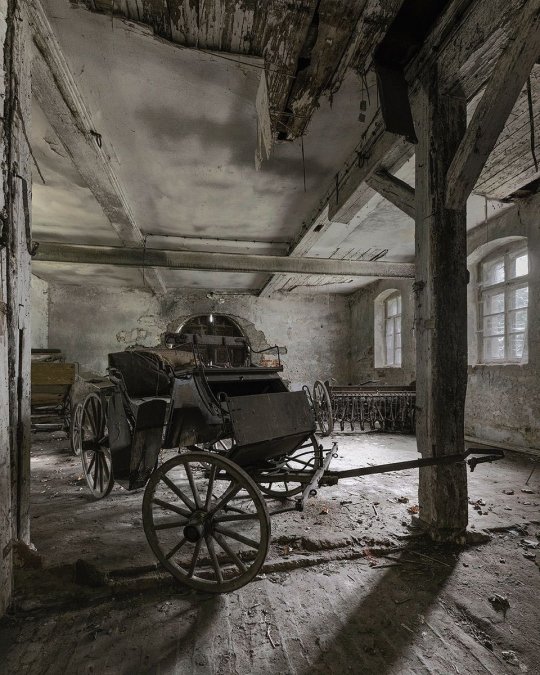
( me / via )
Blind Date.
"And when old Winter puts his blank face to the glass,
I shall close all my shutters, pull the curtains tight,
And build me stately palaces by candlelight."
-Charles Baudelaire, Fleurs du Mal (which tr?) (via @forthetape)
Hinotama.
"Lludd and Llefelys
The scream of two Dragons fighting was the scream of the people confused by two systems of navigation. Similar to using imperial and metric at the same time" --@ThomFear
Ducks changing their minds.
0 notes
Text
In my study into Nodens I’m rereading Lludd and Llefelys, and I just found it interesting that when Beli died the kingdom of the Isle of Britain went to solely to Lludd instead of being divided among his sons. It’s been a bit since I’ve read The Mabinogion and don’t remember off the top of my head if that was normal in these stories, but if I remember correctly, in Welsh history they didn’t practice primogeniture.
Notes for later. I’ll return to this thought
0 notes
Photo
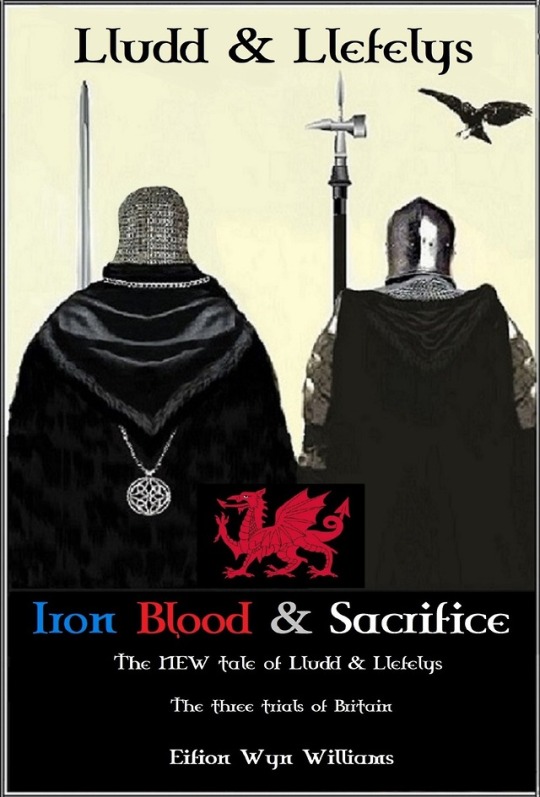
It’s my 62nd birthday today!
You can wish me happy birthday by buying my novella - a bargain at 99 pence!
https://www.amazon.co.uk/dp/B07JH8ZTS6
A 21st Century re-imagining of this ancient tale from the Mabinogion; Lludd & Llefelys.
7 notes
·
View notes
Photo

Mae casgliadau’r Amgueddfa’n cynnwys miloedd o eitemau’n ymwneud â llên gwerin – o hwiangerddi i rigymau, emynau i chwedlau byd natur. Dewch draw i Archwilio eich Archif wrth i ni dwrio trwyddynt.
-
Battling dragons from the story of Lludd and Llevelys, just one of the several thousand folklore items in our archive collections, ranging from nursery rhymes to riddles, folk hymns to nature lore. Join us as we delve into them in a forthcoming event for Explore Your Archive.
#museum#library#archive#wales#dragons#folklore#Lludd and Llefelys#The Mabinogion#vintage illustration#welsh#cymraeg
41 notes
·
View notes
Text
Ludd and Llefelys - a short summary
This is the story of Lludd and Llefelys who rules France and Britain. Britain is overcome by three plagues, which Lludd does not know how to stop. He eventually goes to Llefelys in France, and asks for advice. Llefelys advises him how to stop the plagues, which Lludd follows, clearing Britain of the plagues. Lludd rules Britain in prosperity.
1 note
·
View note
Text
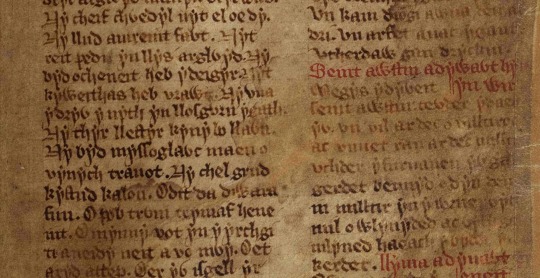
Compiled in Middle Welsh in the 12ᵗʰ-13ᵗʰ centuries from earlier oral traditions, The Mabinogion are the earliest British prose stories. Besides the two main source manuscripts, which date to c.1350-1410, and a few earlier fragments, it was created by various narrators over time; the eleven stories offer drama, philosophy, romance, tragedy, fantasy and humour: there's the classic hero quest, "Culhwch and Olwen"; a historic legend in "Lludd and Llefelys," complete with glimpses of a far off age; and, in other tales, a very different King Arthur to later popular versions.
93 notes
·
View notes
Text



The Mabinogion:
The Mabinogion is a collection of tales from two medieval manuscripts: The White Book of Rhydderch and The Red Book of Hergest. First fully translated from Middle Welsh into English and Welsh by Lady Charlotte Guest in the mid 19th century. The Mabinogion is a series of eleven (sometimes twelve tales depending on which translation you read), often divided into four groups.
The title of the collection, The Mabinogion, is a grammatical error - Lady Charlotte Guest used the term Mabinogion as a plural and the name kind of stuck. Derived from the word Mabinogi coming from the welsh word Mab, meaning boy or youth - this became Mabinogi, meaning tales of youth/boyhood or tales for boys, but it is agreed that Mabinogi as a term in the manuscripts is more likely to mean Tale. (Though the first four branches are the only tales in the Mabinogion that refer to themselves as Mabinogi.)
The tales mix folklore, myth, historical retellings and Arthurian legends, often concerning magical beings, Annwn or the Otherworld in English and Welsh Royalty. There is no single author of the manuscripts, though it is agreed that the first four branches are written by the same author. The manuscripts originated from around 1100-1400; this dating explains the widely different writing styles and references - each tale references aspects of medieval life and the generally agreed upon morals and ethics of the time. In addition to this, the dates of the stories themselves differ wildly. The first four branches and the Tale Lludd and Llefelys predate Christianity as they contain references to the Celtic ‘pagan’ religion in Wales before Christianity, and The Dream of Mascen Wledig is believed to originate from around AD 383. All of the stories in the Mabinogion predate the manuscripts and come from oral traditions/storytelling - the manuscripts are some of the only written evidence we have of these stories.
The Four Branches of the Mabinogi:
Pwyll Pendefig Dyfed/Pwyll, Prince of Dyfed
Branwen ferch Llyr/Branwen, the daughter of Llyr
Manawydan fab Llyr/Manawyddan, the Son of Llyr
Math fab Mathonwy/Math, Son of Mathonwy.
The Three Romances:
Owain/Larlles y Ffynnon/Owain or The Lady of the Fountain/Well Peredur fab Efrog/Peredur, son of Efrawg
Geraint fab Erbin/ Geraint ac Enid/ Geraint, son of Erbin or Geraint and Enid
Native Tales (mix of folklore and retelling of history):
Breuddwyd Macsen Wledig/The Dream of Maxen/Macsen Wledig Lludd a Llefelys/ Lludd and Llefelys
Hanes Taliesin/ The Tale of Taliesin
Arthurian Legend:
Culhwch ac Olwen/ Culhwuch or Kilhwch and Olwen/ The Twrch Trwyth
Breuddwyd Rhonabwy/The Dream of Rhonabwy

The Mabinogion - English translation by Lady Charlotte Guest 1840 - Illustrations by Alan Lee 1982
The Mabinogion - Translated by Sioned Davies
Y Mabinogion - Dafydd a Rhiannon Ifans
https://www.library.wales/discover/digital-gallery/manuscripts/the-middle-ages/white-book-of-rhydderch#?c=&m=&s=&cv=&xywh=-359%2C0%2C4797%2C4079
11 notes
·
View notes
Text
The Native Tales
A series of live lectures via Zoom beginning 16th November, every Tuesday at 8pm UK Time.
The Native Tales of the Mabinogion, these being The Dream of the Emperor Maxen, Lludd and Llefelys, How Culhwch won Olwen and Rhonabwy’s Dream, are a mixture of oral and written, Arthurian and pseudo-historical tales that form a significant part of The Mabinogion. They span at least two centuries of written…
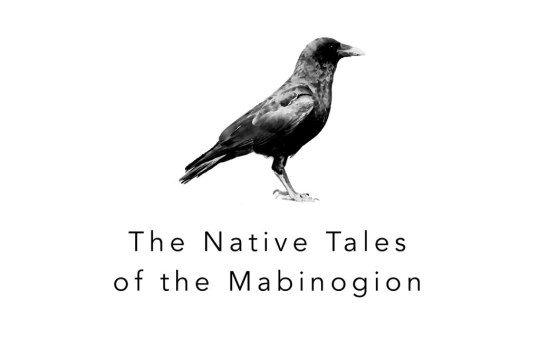
View On WordPress
5 notes
·
View notes
Text
Things We’ve Yelled About This Episode #16
The Hobbit, J. R. R. Tolkien
The Lord of the Rings (films)
The Lord of the Rings, J. R. R. Tolkien
The Silmarillion, J. R. R. Tolkien
This meme:

Harry Potter (aka The Boy Wizard), J. K. Rowling (as always, this podcast thinks Joke Rowling is full of shit, donate to your local trans charity today)
““There is more in you of good than you know, child of the kindly West. Some courage and some wisdom, blended in measure. If more of us valued food and cheer and song above hoarded gold, it would be a merrier world. But sad or merry, I must leave it now. Farewell!”” Thorin Oakenshield, Chapter 18: The Return Journey
““If we don’t get blown off, or drowned, or struck by lightning, we shall be picked up by some giant and kicked sky-high for a football.”” Thorin Oakenshield, Chapter 4: Over Hill and Under Hill
This meme:

and these posts thereupon.
The Princess Bride, William Golding
“The mother of our particular hobbit – what is a hobbit? I suppose hobbits need some description nowadays, since they have become rare and shy of the Big People, as they call us.” Chapter 1: An Unexpected Party
The Three Plagues of Lludd’s town aka Cyfranc Lludd a Llefelys (wiki)
The Historia Regum Britanniae, Geoffrey of Monmouth (wiki)
Brut y Brenhinedd (wiki)
The Icelandic translation of Dracula (post)
Beowulf (wiki) - M recommends the Seamus Heaney or Tolkien translations, but they’re enjoying the Maria Dahvana Headley version immensely.
The Hobbit and LoTR as D&D campaigns, Matt Colville (youtube)
The Secret Commonwealth of Elves, Fauns and Fairies, Robert Kirk and Andrew Lang (wiki)
Elves in Discworld, Terry Pratchett (wiki)
Wheel of Time, Robert Jordan
Babel fish, Hitchhiker's Guide to the Galaxy, Douglas Adams (wiki)
The Poetic Edda (wiki)
For Dwarfish names as Old Norse past participles see this post
Game of Thrones (TV, books by George R. R. Martin)
“Then they went back, and found Thorin with his feet on the fender smoking a pipe. He was blowing the most enormous smoke-rings, and wherever he told one to go, it went – up the chimney, or behind the clock on the mantelpiece, or under the table, or round and round the ceiling; but wherever it went it was not quick enough to escape Gandalf. Pop! He sent a smaller smoke-ring from his short clay pipe straight through each one of Thorin’s. Then Gandalf’s smoke-ring would go green and come back to hover over the wizard’s head.” Chapter 1: An Unexpected Party
M, despite literally never throwing anything out on purpose, can’t find the handout for the lecture they mention on classic fantasy as war literature - if that rings any bells for anyone, let us know so we can credit properly!
J. R. R. Tolkien
C. S. Lewis
The Once and Future King, T. H. White
“Even Bilbo was given a seat at the high table, and no explanation of where he came in – no songs had alluded to him even in the obscurest way – was asked for in the general bustle.” Chapter 10: A Warm Welcome
Shakespeare and listening to women (post)
“It was at this point that Bilbo stopped. Going on from there was the bravest thing he ever did. The tremendous things that happened afterwards were as nothing compared to it. He fought the real battle in the tunnel alone, before he ever saw the vast danger that lay in wait.” Chapter 12: Inside Information
Anansi Boys, Neil Gaiman
Smaug is to the dwarves as the Sackville-Bagginses are to Bilbo (post)
Geralt of Rivia, The Witcher (Netflix)
“ “Well, are you alive or are you dead?” asked Bilbo quite crossly. Perhaps he had forgotten that he had had at least one good meal more than the dwarves, and also the use of his arms and legs, not to speak of a greater allowance of air. “Are you still in prison, or are you free? If you want food, and if you want to go on with this silly adventure – it’s yours after all and not mine – you had better slap your arms and rub your legs and try and help me get the others out while there is a chance!”” Chapter 10: A Warm Welcome
“ “Tomorrow begins the last week of autumn,” said Thorin one day.
“And winter comes after autumn,” said Bifur.
“And next year after that,” said Dwalin, “and our beards will grow until they hang down the cliff to the valley before anything happens here.”” Chapter 11: On The Doorstep
Teen Wolf
“braver than any US marine” meme
This meme:

and commentary
What Else Are We Reading?
Check Please, Ngozi Ukazu (comic)
How To Write An Autobiographical Novel, Alexander Chee
Eat Up!, Ruby Tandoh
The Great British Bake-Off
Next Time On Teaching My Cat To Read
Even More Hobbit (This Time With Moving Pictures)
4 notes
·
View notes
Text
The Welsh Gods/Goddesses and the Seasons (UPG)
Children of Darkness: Winter (water/air)
Llyr (Patriarch/god of the sea), Penardun, Bran, Caradawg ap Bran, Branwen, Creiddylad, Gwern, Efniessin, Niessin, Manawyddan ap Llyr, Rhiannon, Pwyll, Arawn, Pryderi.
Gwynn ap Nudd in is role as King of the Tylwyth Teg and Leader of the Hunt is active said to be active in the winter solstice, but my theory due to Arawn also being said to lead the hunt is that Gwyn ap Nudd leads the hunt on the summer solstice. While he still takes part in the winter solstice Arawn leads the hunt due to his role as King of Annwn, (I believe this, due to his ‘death’ leading him to be unable to leave his kingdom except in the Winter hunt.
The Tylwyth Teg that corresponds: Gwragedd Annwn and Gwyllion (due to the ghost/spirit aspect of their beings)
Children of Light: Summer (fire/ earth)
Don (Matriarch/goddess of the earth. married to the sun god Beli), Manogan, Mathonwy, Beli, Math ap Mathonwy, Arianrhod, Llew Llaw Gyffes, Dylan eil Ton, Gwydion, Gilfaethwy, Afallach, Modron, Mabon ap Modron, Caswallawn, Llefelys, Nudd/Lludd, Gwyn ap Nudd, Edern ap Nudd, Creiddylad, Amaethon, Gofannon, Peibaw, Nynniaw, Penardun
The Tylwyth Teg that corresponds: Bendith y Mamau, Coblynau, Ellyllon
Ceridwen and her children: Spring (water/fire/earth/air)
Ceridwen (Matriarch/ witch or goddess, and is considered to be the goddess of poetry, inspiration and of the cauldron of transfiguration.) Tegid Foal, Crearwy, Morfran, Gwion Bach/Taliesin, Elffin.
The Tylwyth Teg that corresponds: Bwbachod
Like I said in the title this is UPG, how I think of them and how they correspond to the land I live in. Constructive criticism is welcome.
#Cymraeg polytheism#welsh polytheism#welsh myth#welsh folklore#welsh magic#iolo morganwg is most likely a fake#for love of Llyr#the children of darkness have my soul#manawydan#Bran the blessed#Branwyn#rhiannon#ceridwen#pryderi arawn#mypractice
13 notes
·
View notes
Text
Cool! Thank you😊❤️❤️❤️❤️❤️
Dragons from British folklore

The red and white dragons
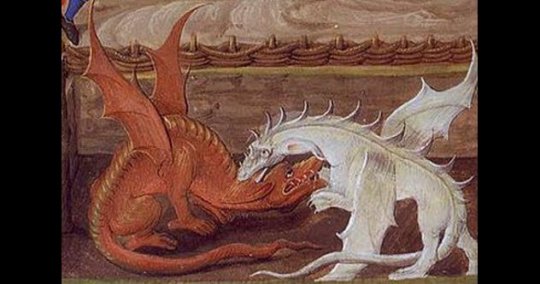
The image of the dragon is an integral part of Welsh identity. As evidence of this, a red dragon is emblazoned on the country’s flag as a symbol of Welsh pride and nationalism.

This dragon, along with a white dragon, appear in The Mabinogion—one of the earliest examples of British prose literature and an important collection of Welsh mythology.

Compiled sometime between the 12th and 13th centuries, the Mabinogion contains numerous tales that have become famous across the world, such as some of the earliest accounts of the Celtic leader King Arthur. “Lludd and Llefelys,” another famous tale, details the important war between the red dragon and the invading white dragon.

In the story, the foreign white dragon is so fearsome that its cries cause women to miscarry and its mere presence is enough to kill livestock and ruin crops. Determined to rid his kingdom of this menace, King Lludd of Britain visits his brother Llefelys in France. Llefelys tells his brother to prepare a pit filled with mead and cover it with cloth. After Lludd completes this task, the white dragon begins to drink from the pit and falls into a drunken stupor. With the monster asleep, Lludd captures the dragon and imprisons it in Dinas Emrys, a wooden hillock in Wales.
One of the more common interpretations of this story is that the red dragon represents the native Celtic inhabitants of Britain while the white dragon is a symbol of the Germanic Anglo-Saxons who began invading England in the fifth century. A related idea is that the white dragon is the symbol of the Saxon warlord Vortigern while the red dragon is the flag of King Arthur’s forces. Either way, “Lludd and Llefelys” does show a close relationship between Celtic Britain and Gaul (today’s France), which may make this story’s origins even older than the fifth century.
Dragon of Loschy Hill

“The Dragon of Loschy Hill” is a tragic Yorkshire tale that is recounted by Reverend Thomas Parkinson in his 1888 book Yorkshire Legends and Traditions. According to Parkinson’s account, a large dragon once haunted a wooded area later known as Loschy’s Hill in the parish of Stonegrave. As the dragon terrified local villagers, a brave knight named Peter Loschy decided to kill the beast once and for all. While wearing a special suit of armor that featured several razor blades, Loschy and a trusted dog set out to find the dragon.

Feeling confident that the knight would be just another meal, the dragon wrapped itself around Loschy’s armor and tried to squeeze the human into eternal submission. Loschy’s armor gave the dragon numerous cuts, but all of them healed quickly. Although stunned by the dragon’s supernatural powers, Loschy managed to cut off pieces of the dragon’s skin with his sword. His dog then carried the pieces to Nunnington Church. Loschy and his dog managed to dismember the dragon so thoroughly that it could not regenerate. Loschy was so overjoyed that he didn’t realise that his face was coated in the dragon’s poison. Upon licking his master’s face, the faithful dog ingested the poison and died. In turn, the poison fumes became too much for Loschy, and he died by his dog’s side.

As a show of gratitude, the villagers of Stonegrave buried Loschy next his dog in Nunnington Church, where stone engravings retell the story for all to see.
Sockburn worm

The Sockburn worm is a wyvern, not a dragon. Although a relative of the dragon, northern European folklore depicts wyverns as smaller creatures with the head of a dragon, the body of a snake, the wings of a bat, and two legs that protrude above a long, serpentlike tail. Despite being smaller than dragons, wyverns were known for being exceptionally vicious. The Sockburn worm was no different.
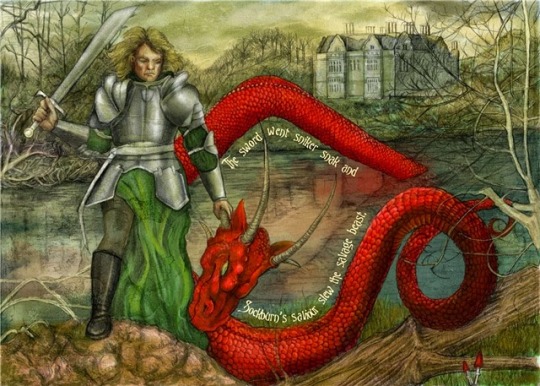
Not long after the Norman Conquest, the Sockburn worm began terrorising the country surrounding the River Tees in County Durham. The Sockburn worm used its ability to fly and its poisonous breath to wreak havoc all across the Sockburn Peninsula. Realising that the wyvern must be killed to save the realm, a knight named Sir John Conyers visited a church and offered up the life of his only son to God in preparation for the battle. A document known as the Bowes Manuscript asserts that Conyers not only killed the wyvern but earned land and a title because of his heroism.
Some historians have suggested that the Sockburn worm represents a marauding Danish warrior while others see Conyers as a Norman knight who helped to legitimize Anglo-French rule in the northeast.

Whatever the truth, the weapon that Conyers supposedly used to kill the Sockburn worm is still on display in the Durham Cathedral and is called the Conyers falchion.
Mester Stoor worm

Located in the far north of Scotland, the Orkney Islands have an ancient history that stretches all the way back to the Stone Age. During the ninth century, Orkney fell prey to numerous Viking raids from Norway. Ultimately, the islands were settled by Scandinavians who helped to annex the islands for Norwegian and later Dano-Norwegian kings. As the Orkneys offered a way for Germanic and Celtic cultures to interact, the islands became home to unique folklore. As part of that folklore, the Mester stoor worm remains a thoroughly Orcadian tale.

As the legend goes, the Mester stoor worm was a gigantic sea serpent that could wrap itself around the entire world. When it moved, the Mester stoor worm caused earthquakes and other natural disasters. Owing to the monster’s poisonous breath and its habit of smashing ships to pieces, most knights steered clear of the creature. One day, a powerful wizard promised the king that the sea beast could be killed if the king gave up his daughter to the wizard. Not wanting to lose his daughter, the king offered the entire kingdom to any brave warrior who killed the Mester stoor worm.
An unlikely hero emerged by the name of Assipattle, a slow-witted farm boy who killed the dragon by guiding a ship into the dragon’s stomach. There, Assipattle applied burning peat to the dragon’s liver, which eventually caused an explosion that forever rid the world of the Mester stoor worm. According to the legend, the dead beast did bring about a positive change, for the dragon’s scattered teeth created the Orkney Islands.
Bignor Hill dragon
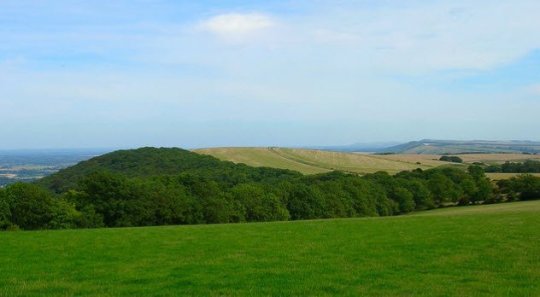
Not much is known about the Bignor Hill dragon. Its name appears only sporadically in the historical record, yet the few clues about the beast are quite tantalizing. In the 19th century, The Gentleman’s Magazine recorded that the local inhabitants of Bignor Hill, an area in Sussex dotted with Roman roads, believed that an ancient Celtic dragon lived on top of a nearby hill.

Some folktales spoke of the surrounding hills as being part of the dragon’s skinfolds while others pointed out that the dragon’s den was close to a ruined Roman villa. This later tale is interesting because it may highlight an interpretation of the Bignor Hill dragon as some sort of holdout from the Roman occupation of Britain, which introduced the Roman religion on the island. The notion that the dragon is of Celtic origin likewise points to a Christian demonetisation of pagan practices. Although the origins of the Bignor Hill dragon are unknown, Sussex is awash in dragon tales, making it a treasure trove of dragon folklore.
Lyminster knucker

Lyminster, Sussex, was once home to a knucker. Based on the Old English word nicor, which means “water dragon,” knuckers are predominately found in knuckerholes, ponds that are present throughout Sussex. The Lyminster knucker lived in one such knuckerhole near the major church of Lyminster. The knucker began its reign of terror by snatching away livestock. Then the water dragon began dragging away all the young girls from the village until the only maiden left was the king’s daughter. With few options left, the king of Sussex offered his daughter as the prize for anyone who could slay the dragon.

Three different versions of the legend record three different heroes. One legend has it that a wandering knight killed the dragon before taking the princess as his wife. In another version, a local man named Jim Puttock kills the dragon by feeding it poisoned pudding. A third version says that a man named Jim Pulk slays the dragon with poisoned pudding but forgets to wash the dragon’s poison off his skin and dies as a result.
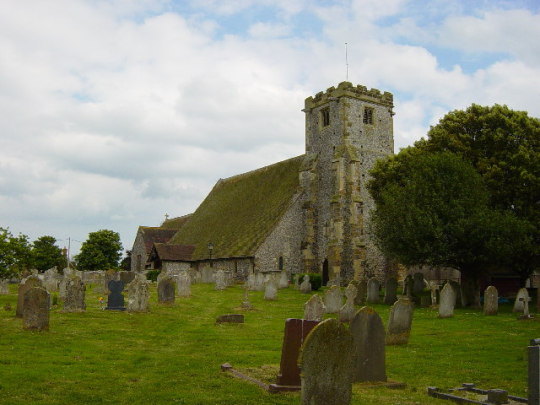
These competing versions merely highlight the importance of the Lyminster knucker story to Sussex folklore. St. Mary Magdalene’s Church in Lyminster is still known as the home of the “Slayer’s Slab“—a tomb that supposedly houses the bones of the man who killed the Lyminster knucker.
Laidly worm of Spindleston Heugh

“The Laidly Worm of Spindleston Heugh” began as a Northumbrian ballad that was passed down through song in northern England. The story begins with the king of Northumbria, who lived inside Bamburgh Castle with his wife and children. When the first queen died, the king took a malicious witch as his bride. The king’s strong son, Childe Wynd, is out to sea, so there is no one in the castle who can stop the witch’s evil plans. Jealous of the beautiful Princess Margaret, the witch turns the young girl into a dragon. The princess remains that way until Childe Wynd returns and kisses the dragon. The prince’s kiss breaks the spell, which allows the prince to claim the throne. As revenge, Childe Wynde curses the witch and turns her into a toad.

This is just one version of this classic tale. In another version, the castle is called Bamborough and the witch’s curse is far worse.

Princess Margaret becomes an uncontrollably hungry dragon that must feast upon the area livestock. However, both versions draw inspiration from the Icelandic saga of the shape-shifter Alsol and her lover Hjalmter.
The Mordiford wyvern

The story of Maud and the Mordiford wyvern is a rather unusual legend. Set in the Herefordshire village of Mordiford, the story concerns a young girl named Maud who finds a baby wyvern while out walking one morning. Maud takes the small creature back to her home as a pet and feeds it milk regularly.

As the creature grows older, it develops a taste for human flesh and begins dining on the Mordiford villagers. Despite its cruelty, the wyvern remains loyal to Maud and refuses to eat her. However, even Maud cannot get the wyvern to stop its killing spree. It makes its home on a nearby ridge and its constant movements back and forth create the Serpent Path, a twisting road that ends at a local river. Several versions of the creature’s demise exist. In one, the scion of the Garston family manages to kill the beast after a fierce ambush. Another version says that a condemned criminal killed the wyvern to escape capital punishment.
The Dragon of Longwitton

For a time, the inhabitants of Longwitton, Northumberland, were barred from three holy wells. This was not because the water was poisoned but rather because a fearsome dragon kept them away. A hero did not appear until a knight named Sir Guy, Earl of Warwick accepted the task of killing the dragon. For three days, Sir Guy and the dragon fought each other. During that time, Sir Guy grew disenchanted because each cut and stab did nothing to the dragon. Once struck, the dragon simply used magic to heal its own wounds.

On the third day, Sir Guy noticed that the dragon kept its tail inside one of the wells throughout the battle. Realising that the sacred waters allowed the dragon to constantly heal itself, Sir Guy persuaded the dragon to move away from the wells entirely, thereby leaving it vulnerable. Once away from the holy waters, Sir Guy easily managed to kill the creature.
More detailed versions of the story proclaim that the waters were known for their healing properties throughout Northumbria, and as such, the dragon coveted the wells for its own purposes. In some tales, the brave knight also uses a magic ointment to protect himself from the dragon’s breath.
Worm of Linton

According to 12th-century stories from the Scottish Borders, the Linton worm lived in the “Worm’s Den”—a hill near the village of Linton in Roxburghshire. At dusk and dawn, the dragon left its den to prey upon sheep, cows, and people. All the weapons used against the creature proved useless, and before long, Linton had been reduced to a wasteland.
When word of the dragon reached the ears of William (or John) de Somerville, the Laird of Lariston, the courageous knight decided to act. Riding north, de Somerville noticed that the dragon frequently consumed everything that stood in its way. However, when faced with something too large to swallow, the dragon would lie still with its mouth open. Realising that this made the dragon vulnerable, de Somerville had a blacksmith create an iron spear with a wheel on its tip. De Somerville placed burning peat on top of the wheel. When he journeyed inside the worm’s mouth on horseback, he placed the fire inside of the dragon, creating a fatal wound.

In its death throes, the Linton worm’s thrashing body created the many hills that today populate the region. For his actions, Linton Church (or Kirk) created a carved stone to record the story for posterity.
In some versions, the death of the Linton worm occurred during the reign of King William the Lion,

who ruled Scotland from 1143 until 1214. Supposedly, King William greeted de Somerville as “my gallant Saint George” to enhance the nobleman’s confidence. Also, besides the carved stone in Linton Church, de Somerville’s victory is supposedly commemorated by the de Somerville coat of arms, which features a green, fire-breathing dragon on top of the tympanum.
90 notes
·
View notes